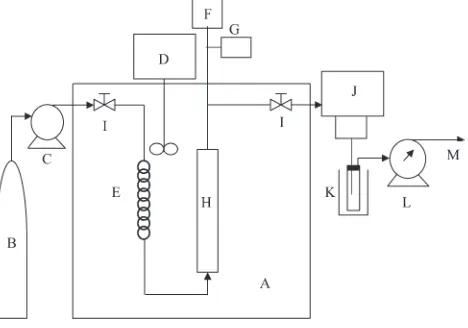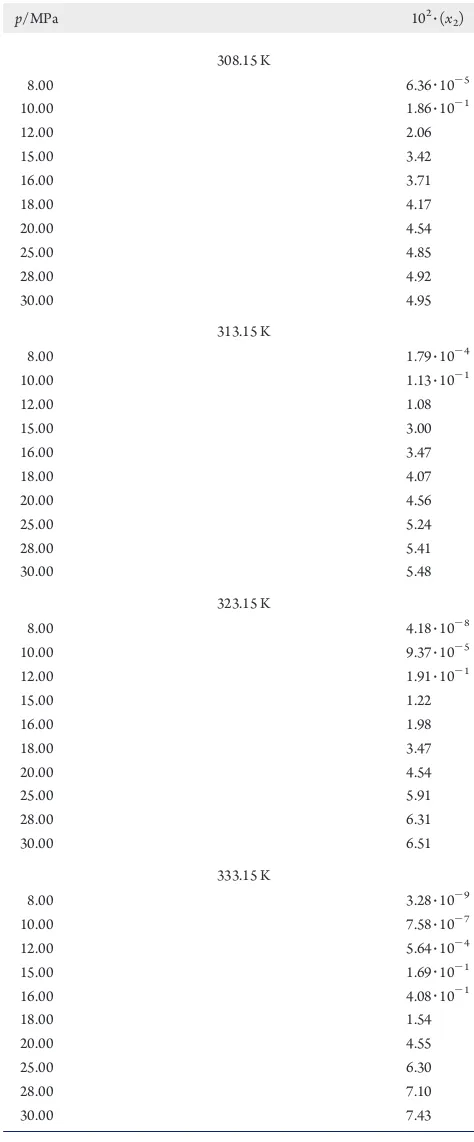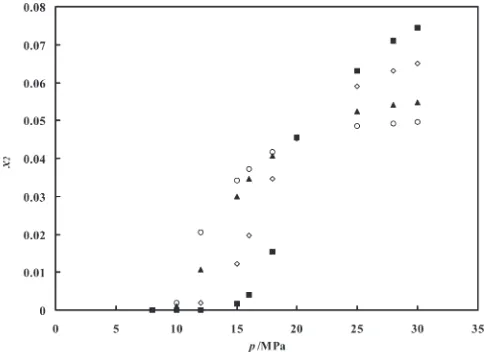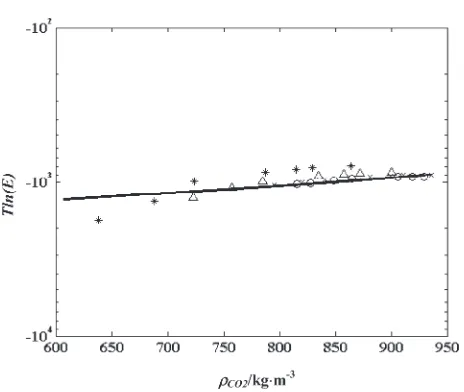Published: February 25, 2011
pubs.acs.org/jced
Solubility of Corosolic Acid in Supercritical Carbon Dioxide and Its
Representation Using Density-Based Correlations
Andri C. Kumoro*
Department of Chemical Engineering, Faculty of Engineering, Diponegoro University Prof. H. Soedarto, SH Road, Tembalang-Semarang 50239, Indonesia
ABSTRACT:The solid solubilities of 2R,3β-dihydroxyurs-12-en-28-oic acid (corosolic acid) in supercritical carbon dioxide (SC-CO2) have been measured using a dynamic method at (308.15, 313.15, 323.15, and 333.15) K over a pressure range of (8 to 30) MPa. Prior to solubility measurements, the accuracy of the experimental apparatus was examined by measuring solubilities of squalene in SC-CO2and comparing them with literature. The corosolic acid solubilities ranged from a corosolic acid mole fraction of 3.28310-11at 333.15 K and 8 MPa to 7.43
310-2at 333.15 K and 30 MPa. The del Valle and Aguilera and Mendez-Santiago and Teja (density-based) models were used to correlate the experimental data. The calculated solubilities showed good agreement with the experimental data in the temperature and pressure ranges studied.
’INTRODUCTION
Diabetes mellitus is one of the world's major health problems. In the developed countries, diabetes mellitus patients may have proper treatments, such as controlled low sugar diet and admin-istration of insulin and/or hypoglycaemic agents. Unfortunately, patients in the developing countries may not be able to afford these methods due to their socio-economic conditions.1This fact has prompted to the high prevalence of noncompliance observed in minority, disadvantaged communities in the developed coun-tries, and rural folks in the developing countries.2In addition, medical centers are not always available within the reach of these population groups, and rural folks prefer to seek traditional medi-cations rather than the modern ones. In Asia and South America, the development and use of inexpensive and easily accessible phytomedicines from plants of the genusSyzygiumin the treat-ment of diabetes mellitus is encouraged to overcome these problems.3
Corosolic acid (2R,3β-dihydroxyurs-12-en-28-oic acid, IUPAC 1S,2R,4aS,6aR,6aS,6bR,10R,11R,12aR,14bR)-10,11-dihydroxy-1,2, 6a,6b,9,9,12a-heptamethyl-2,3,4,5,6,6a,7,8,8a,10,11,12,13,14b-tetradecahydro-1H-picene-4a-carboxylic acid, CAS Registry No. 4547-24-4, Figure 1) is one of the secondary metabolites contained in the leaf ofSyzygium cumini, which has antidiabetic activity.4,5Miura and coworkers6reported an acute hypogly-cemic effect of corosolic acid, which was shown by an increase in GLUT4 translocation in mouse muscle. In addition, they also found that corosolic acid promotes glucose metabolism by redu-cing insulin resistance. The action of insulin is mediated by tyrosine phosphorylation and initiated by the binding of insulin to the insulin receptor. Corosolic acid may act as an insulin sensitizer, enhancing insulin receptor B phosphorylation indir-ectly by inhibiting certain nonreceptor protein tyrosine phosphatases.7Latter, Fukushima et al.5have discovered coro-solic acid ability to reduce post challenge plasma glucose levels in humans. Another study reported that corosolic acid inhi-bited gluconeogenesis by increasing the production of the gluco-neogenic intermediate fructose-2,6-bisphosphate in isolated
hepatocytes.8,9 Bhat et al.10 have demonstrated various levels antidiabetic activity of corosolic acid obtained from aqueous and organic solvent extraction ofS. cuminiplant leaf. No antidiabetic activity was shown by aqueous and methanol extracts, while chlo-roform extract showed good antidiabetic activity. In addition, it has also been reported that in general, secondary metabolites are highly unstable depending on factors like temperature, light, oxygen, and solvent used in the extraction.11-14
Supercriticalfluid extraction (SFE) has shown its superiority over conventional solvent extraction techniques. The absence of both light and air during the extraction process along with relatively mild operating temperatures can reduce the tendency of degradations, while the use of CO2as solvent allows working in an environmentally clean media. The possibility of adjusting the supercritical solvent power based on its density is the key factor in the extraction process. Then, information of solubility of corosolic acid in the supercritical condition is necessary for the analyses and optimization of corosolic acid extraction and purification units.
This article reports experimental measurements of corosolic acid solubilities in supercritical CO2, which, to the best of the author knowledge, has not been reported in the literature until present. Four density-based correlations on the solubility of solute in supercritical CO2were used in this work to represent the solubility data.
’EXPERIMENTAL METHODS
Materials. Corosolic acid (C30H40O4, purity > 0.96 mass fraction) was purchased from Dalian GreenPeak Biotech Co. Ltd. China and used as received without any further treatments. Deionized water, squalene (Fluka Chemie, high-performance liquid chromatography (HPLC) grade, purity g 0.97 mass
fraction) and anhydrous methanol (HPLC grade, purityg0.998
mass fraction) were purchased from Sigma-Aldrich Pte. Ltd. Singapore and stored at 291.15 K. Orthophosphoric acid (HPLC grade, purityg0.998 mass fraction) was purchased from Merck,
Germany. Carbon dioxide (0.99 mass fraction) was provided in liquid form in cylinders equipped with a diptube, and it was further purified by passing it through a 2μm filter (PT. Aneka Gas, Indonesia).
Procedure.The solubility of corosolic acid in supercritical carbon dioxide (SC-CO2) was determined using a dynamic method. This method is based on the assumption that the solute-solvent system reaches equilibrium as the solvent flows over the solute.15 Preliminary solubility measurements were carried out by delivering carbon dioxide (liquid based) into the equilibrium cell at flow rates ranging from (6.67310-9 to 3.33310-8) m3
3s-1 for about 4 h. Variation of the flow rate within this range was found to have no effect on the observed solubilities, thereby confirming that equilibrium between the solid phase and the fluid phase was achieved at these flow rates and that there were no mass-transfer limitations. Hence, the supercritical carbon dioxide solvent leaving the extraction vessel was saturated with the solute and equilibrium between the solid and the supercritical phase was achieved. The solubility of corosolic acid in SC-CO2was measured using the same apparatus that was described in the literature16and explained briefly here (see Figure 2). The main apparatus was a 1.6310-5m3 high-pressure stainless steel equilibrium cell (H) (10 mm inner diameter 210 mm length) immersed in a water bath (A) controlled by an electrical heater (D) (model DC10, Thermo Haake) to within(0.1 K uncertainty. The system pressure was indicated by a pressure transducer (G) (model PDCR 961, Druck). Its uncertainty was(0.01 MPa in the pressure range of (8 to 30) MPa, while an HPLC pump (C) (model LC-6A, Shimadzu Co.) was used to compress the liquid CO2 and to deliver it at a constant volumetric flow rate of 1.67310-8m3
3s-1. The CO2was depressurised to atmospheric by a back pressure regulator/BPR (J) (model BP 1580-81, JASCO) with uncer-tainty of(0.01 MPa and the amount of CO2consumed was quantified using a wet gas meter (L) (model DM 3A, Alaxander Wright & Co.) within the time of measurement to calculate the expanded gas flow rate (( 1.0310-10 m3
3s-1). The solute collected was gravimetrically determined using an analytical balance (model AG 204, Mettler Toledo) with an accuracy of (0.0001 g. However, when the amount of corosolic acid was not possible to be measured using the analytical balance, then the HPLC analysis was applied to quantify the exact amount of corosolic acid in the vial. It was done by washing the vial using a solution, which was a mixture of methanol and aqueous ortho-phosphoric acid. The concentrations of methanol and orthopho-sphoric acid in the solution were 27.39 mol3kg1-and 1.25
310-2 mol3kg1-, respectively. The collected washing liquid was then
subjected to corosolic acid analysis using the HPLC method.16
This method was valid for corosolic acid concentration ranged from (4.5 to 400) g3m-3. Prior to solubility experiments, the equilibrium cell was washed with ethanol, dried in an electric oven at 373.15 K for one hour, and cooled in a desiccator. On the other hand, the tube lines, fittings, and connections were cleaned up by flushing liquid CO2at 3.33310-8m33 s-1for about 900 s to totally remove dirt and solute.
A total of 10 g of corosolic acid was charged into a stainless-steel equilibrium cell by arranging it into alternative layers of about 500 mg and glass beads (30 to 60) mesh, with glass wool at either end. The function of the packing was to improve corosolic acid-SC-CO2contact, reduce channeling of the SC-CO2, and prevent corosolic acid entrainment.17The equilibrium cell was heated to the prescribed temperature value by immersing it in a controlled temperature water bath. The liquid CO2was pressur-ized and delivered at aflow rate of 1.67
310-8m33s-1using a reciprocating HPLC pump to pass through a heating coil immer-sed in the water bath and enabled CO2 to reach the desired temperature before entering the equilibrium cell at a constant pressure. The system pressure was maintained by a back-pressure regulator, and the value was indicated by a test gauge. The satu-rated SC-CO2 was then depressurized by the BPR to atmo-spheric, and the dissolved compound was trapped and collected in a vial cooled in a table salt solution of 277.15 K after exiting from the BPR. To prevent precipitation of the solute between BPR and the trap, short tape heater tubing and the BPR-heater-jacket temperature of 333.15 K were used. The weight loss of the cell was also compared with the weight of the collected solute to ensure at least 96 % of trapping efficiency during solubility measurements. The solubility was defined as the mole fraction of the solutes in the expanded CO2. The corosolic acid solubility experiments were performed at (308.15, 313.15, 323.15, and 333.15) K and at pressures ranging from (8 to 30) MPa. The reproducibility of the measurements was confirmed by making triplicates of each measurement to obtain reliable solubility values, and an average value was given. The estimated uncertainty of the solubility values based on error analysis and repeated observations was within 2 %. To verify the accuracy of the solubility measure-ments and the method employed, the solubility of squalene in SC-CO2had been measured and compared with the literature values. Figure 1. Structure of the corosolic acid molecule.
Figure 2. Schematic diagram of isothermal solubility measurement apparatus. A, constant temperature water bath; B, CO2tank; C, CO2
’RESULTS AND DISCUSSION
Apparatus Validation.It was imperative for the author to ensure that the experimental technique was adequate. However, no literature values for corosolic acid solubility in SC-CO2could be found. Fortunately, the solubility of a close compound in the same homologous series (i.e., squalene) in SC-CO2is available in the literature, which could have served as an indirect way to validate the results. Experiments were performed at (323.15 and 333.15) K and at pressures of (10 to 27.5) MPa. The procedure was identical to that used for the corosolic acid experiments, includ-ing equilibrium determination and runs in triplicate. Table 1 presents and compares the experimental solubility of pure squalene in SC-CO2 (grams of squalene per kilograms of CO2) at pressures of (10 to 27.5) MPa obtained from this work and those reported by Catchpole and von Kamp.18The experi-mental results show good agreement with the literature, where the solubility values obtained in this work are almost equal with those reported in the literature. These results validate the experimental method used in this study.
Solubility Data.The solubility values of corosolic acid in pure SC-CO2obtained in this work are summarized in Table 2 and plotted in Figure 3. Most of the CO2density values were ob-tained from the National Institute of Standards and Technology (NIST) fluid property database.19When the CO2density value was not readily available, its value was then predicted using REFPROP program available in the NIST database. In general, as pressure increased at constant temperature, the solubility of corosolic acid in SC-CO2 also increased. This was expected because an increase in SC-CO2pressure at a constant tempera-ture results in increasing its density and thereby its solvent strength (ability of a solvent to dissolves solute).20The increases of CO2 density with pressure causing a decrease of the inter-molecular distances which increases the solute-solvent interac-tion. Therefore, at lower pressures, corosolic acid solubility in SC-CO2at 333.15 K is the lowest. In addition, temperature also affects the solute vapor pressure, the solvent density, and the intermolecular interactions in the fluid phase. At a constant pressure, an increase in temperature will reduce the ability of SC-CO2to dissolve corosolic acid due to the reduction of SC-CO2 density.20 On the other hand, an increase in temperature will increase the vapor pressure of corosolic acid, which leads to an increase in the dissolution of corosolic acid in SC-CO2. There-fore, it is not surprising that a crossover pressure occurs between at about 20.0 MPa. Such retrograde behavior has also been
reported before for different organic compounds.21,22The cross-over phenomena could be attributed to the competitions be-tween solute's vapor pressure and solvent's density, whose temperature dependences are in opposite directions. At the crossover point, the effects of solute vapor pressure and solvent density on solid solubility balance each other. From the crossover
Table 1. Solubility of Squalene in CO2
p/MPa
323.15 K/g3kg-1 333.15 K/g3kg-1
Catchpole and
von Kamp17 this work
Catchpole and
von Kamp17 this work
10.0 0.27 0.26
Table 2. Mole Fraction Solubility (x2) of Corosolic Acid in
pressure point and upward, the solubilities of corosolic acid in SC-CO2at 333.15 K were higher than at any other tempera-tures in this study. This phenomenon indicated that the vapor pressure of corosolic acid began to have a dominant effect on solubility.17,23
Modeling.There are two most common approaches in the
modeling of solubility of solute in supercritical fluid, namely, the so-called semiempirical methods and the equation-of-state (EOS) methods. Considering the calculation simplicity and further applications, some semiempirical correlations were tested in this work.
By assuming chemical association equilibrium between the solute and the compressed gas, Chrastil developed a theory based on the mass action law applied to the formation of a solvate complex between a solute molecule and a number of supercritical fluid (SCF) solvent molecules.24 It should be noted that the associated solvate complex assumption is quite close to the cluster conception accepted by the community.25Based on the facts thatkis a function of density26and that the solubility is a function of temperature, del Valle and Aguilera proposed a model to help compensate for the change in the heat of vaporization with temperature in the original Chrastil model. They also recommended the equation to be used for a temperature range from (293 to 353) K and for pressure varying from (15 to 88) MPa.27
This idea leads to the following equation for the solubility of component 2 (solid or liquid) in component 1 (SCF):
lnS ¼klnFfþAþB
In eq 1,Sis the concentration of solute in the supercriticalfluid (kg3m-3);F
fis the density of the supercriticalfluid (kg3m-3);k is an association number;Ais a function of the molecular weights of the solute and supercritical fluid; B andC are parameters related to the heat of solvation and heat of vaporization; andTis temperature (K). In eq 2, MW1, MW2, andx2are the molecular weight of SCF and solute and mole fraction solubility of solute in SCF, respectively.
The measured solubility values are usually much greater than predicted using ideal gas theory. The extent to which pressure enhances the solubility of the solid in the gas is shown by an examination of the enhancement factorsEof the solutes, where:
E ¼ x2P P2sat
ð3Þ
andPis the total system pressure, andP2satis the saturation (or, for solid solutes, sublimation) pressure of the pure solute. The vapor pressure of the solid, necessary to calculate the enhance-ment factor using eq 3, can be predicted according to the method proposed by Grain.28On the basis of the dilute solutions theory, Mendez-Santiago and Teja29proposed the other model tofit the corosolic solubility data, which started with Henry's constant of the dilute solution and demonstrated that the solubility plotted as
TlnEagainst the density of the solvent would yield a single line. They also concluded that the fact that all isotherms collapse to a single line is thus a powerful tool to determine the self-consis-tency of experimental data. The model can be written as
TlnE¼ DþFFf ð4Þ
whereDandFare the equation parameters. BothDandFare independent of temperature.
In the calculations, the objective function used is the average absolute relative deviation (AARD) between the calculated and experimental solubility:
whereNis the number of experimental data points. Thex2expand
x2calc are experimental and calculated solubility values, respectively.
The parametersA,B,C, andkto facilitate the incorporation of effect of temperature and solvent density of the del Valle and Aguilera (DVA) equation together with the AARD between experimental and calculated solubility are presented in Table 3. The plots of the experimental data and the solubility isotherms calculated with the DVA model are presented in Figure 4, where the quality of the correlations can be visually evaluated. It is obvious in Figure 4 and Table 3 that the model still produced reasonable solubility estimation compared with the experimental data, where an AARD of 17.2 % was obtained. The correlation improves largely when the correlation parameters were evaluated without taking into account the low solubility data since solubi-lities are often in the same order of magnitude, as this equation does not require the thermodynamic properties of the pure component which is not always available in the literature. Figure 3. Mole fraction solubility (x2) of corosolic acid in supercritical
carbon dioxide at elevated pressure:O, 308.15 K;2, 313.15 K;], 323.15 K; 9, 333.15 K.
Table 3. Optimized Parameters of the DVA and MST Equa-tions for Corosolic Acid Solubility in Supercritical Carbon Dioxide
MST D= 11957.5581 14.7
When vapor pressure data is available, the original version of the MST model is very useful for data correlation because of its simplicity and goodfitting results. With the purpose of regression analysis of the MST equation,P,F, andTwere expressed in MPa, kg3m-3, and K, respectively. The values for
DandFobtained via multilinear regression are reported in Table 3. Although MST equation uses only two adjustable parameters, it results in better solubility calculations than DVA equation by generating an AARD as low as 14.7 %. Figure 5 shows that the data points for the four isotherms follow a single trend, indicating good consistency of the data over the range of temperatures tested. It may be observed that the model reproduces much better calculation when the parameters are obtained without including the solubilities obtained at pressures in the vicinity of the critical point of carbon dioxide.
’CONCLUSIONS
The solubility of corosolic acid in supercritical carbon dioxide has been measured experimentally. The solubility varied from a mole fraction of 3.28310-11 at 333.15 K and 8.0 MPa to 7.43310-2at 333.15 K and 30.0 MPa. In general, the solubility of corosolic acid increased with increasing pressure at constant temperature. Overall, the solubility of corosolic acid in super-critical carbon dioxide increased with pressure at a constant temperature. Retrograde behavior of this system was indicated by a crossover pressure at 20.0 MPa. The solubility data were modeled with two density based semiempirical equations. The MST equation performed its superiority over the DVA models in term of accuracy with an AARD of 14.7 %, and its also success-fully tested the consistency of the data. To the author's knowl-edge, this is thefirst reported data of corosolic acid solubility in SC-CO2.
’AUTHOR INFORMATION
Corresponding Author
*Tel.: þ62-24-7460058, Fax: þ62-24-76480675, e-mail: c.k. [email protected].
Funding Sources
The author would like to express their gratitude to the Directo-rate General of Higher Education, Ministry of National Educa-tion The Republic of Indonesia for itsfinancial support through Hibah Kompetensi/Competence Research Grant 2010.
’REFERENCES
(1) Ducorps, M.; Ndong, W.; Jupkwo, B.; Belmejdoub, G.; Thiolet, C.; Mayaudon, H.; Bauduceau, B. Diabetes in Cameroon. Classification
difficulties in Africa.Med. Trop.1996,56, 264
–270.
(2) Dyer, P. H.; Lloyd, C. E.; Lancashire, R. J.; Bain, S. C.; Barnett, A. H. Factors associated with clinic non-attendance in adults with type-1 diabetes mellitus.Diabetic Med.1998,15, 339–343.
(3) Teixeira, C. C.; Pinto, L. P.; Kessler, F. H.; Knijnik, L.; Pinto, C. P.; Gastaldo, G. J.; Fuchs, F. D. The effect ofSyzygium cumini(L.)
skeels on post-prandial blood glucose levels in non-diabetic rats and rats with streptozotocin-induced diabetes mellitus.J. Ethnopharmacol.1997, 56, 209–213.
(4) Wen, X.; Sun, H.; Liu, J.; Wu, G.; Zhang, L.; Wu, X.; Ni, P. Pentacyclic triterpenes. Part 1: thefirst examples of naturally occurring
pentacyclic triterpenes as a new class of inhibitors of glycogen phos-phorylases.Bioorg. Med. Chem. Lett.2005,15, 4944–4948.
(5) Fukushima, M.; Matsuyama, F.; Ueda, N.; Egawa, K.; Takemoto, J.; Kajimoto, Y.; Yonaha, N.; Miura, T.; Kaneko, T.; Nishi, Y.; Mitsui, R.; Fujita, Y.; Yamada, Y.; Seino, Y. Effect of corosolic acid on postchallenge
plasma glucose levels.Diabetes Res. Clin. Pract.2006,73, 174–177.
(6) Miura, T.; Ueda, N.; Yamada, K.; Fukushima, M.; Ishida, T.; Kaneko, T.; Matsuyama, F.; Seino, Y. Antidiabetic effects of corosolic
acid in KKAy diabetic mice.Biol. Pharm. Bull.2006,29, 585–587.
(7) Shi, L.; Zhang, W.; Zhou, Y. Y.; Zhang, Y. N.; Li, J. Y.; Hu, L. H.; Li, J. Corosolic acid stimulates glucose uptake via enhancing insulin receptor phosphorylation.Eur. J. Pharmacol.2008,584(1), 21–29.
(8) Klein, G.; Kim, J.; Himmeldirk, K.; Cao, Y.; Chen, X. Antidia-betes and anti-obesity activity of Lagerstroemia speciosa.Evidence-Based Complement. Alternat. Med.2007,4(4), 401–407.
(9) Yamada, K.; Hosokawa, M.; Fujimoto, S.; Fujiwara, H.; Fujita, Y.; Harada, N.; Yamada, C.; Fukushima, N.; Ueda, N.; Kaneko, T.; Matsuyama, F.; Yamada, Y.; Seino, Y.; Inagaki, N. Effect of corosolic
acid on gluconeogenesis in rat liver.Diabetes Res. Clin. Pract.2008,80, 48–55.
(10) Bhat, M.; Zinjarde, S. S.; Bhargava, S. Y.; Kumar, A. R.; Joshi, B. N. Antidiabetic Indian Plants: a Good Source of Potent Amylase Figure 4. Solubility (S) of corosolic acid in carbon dioxide as a function
of carbon dioxide density and temperature:O, 308.15 K;, 313.15 K;4,
323.15 K;/, 333.15 K. The lines are the bestfit of the experimental data
calculated with DVA equation;— 3 3, 308.15 K;— 3, 313.15 K;- -, 323.15 K;—, 333.15 K.
Figure 5. Enhancement factor (E) of corosolic acid solubility in supercritical carbon dioxide as a function of carbon dioxide density:
O, 308.15 K;, 313.15 K;4, 323.15 K;/, 333.15 K;
—is the bestfit line
Inhibitors. Evidence-Based Complement. Alternat. Med. 2008, 1-6; doi:10.1093/ecam/nen040
(11) Schwarz, K.; Ternes, W. Antioxidative constituents of Rosmar-inus officinalisand Salvia officinalisII. Isolation of carnosic acid and formation of other phenolics diterpenes. Z. Lebensm. Unters. Forsch. 1992,195, 99–103.
(12) Schwarz, K.; Ternes, W.; Schmauderer, E. Antioxidative con-stituents of Rosmarinus officinalis and Salvia officinalis III. Stability of
phenolic diterpenes of rosemary extracts under thermal stress as required for technological processes.Z. Lebensm. Unters. For.1992,195, 104–107.
(13) Cuvelier, M. E.; Berset, C.; Richard, H. Antioxidant constitu-ents in sage (Salvia officinalis).J. Agric. Food Chem.1994,42, 665–669.
(14) Okamura, N.; Fujimoto, Y.; Kuwabara, S.; Yagi, A. High-performance liquid chromatographic determination of carnosic acid and carnosol inRosmarinus officinalisandSalvia officinalis.J. Chromatogr., A1994,679, 381–386.
(15) Maxwell, R. J. Solubility Measurements of Lipid Constituents in Supercritical Fluids. Supercritical Fluid Technology in Oil and Lipid Chemistry; AOCS Press: Champaign, IL, 1996.
(16) Olszewska, M. Optimization and Validation of an HPLC-UV Method for Analysis of Corosolic, Oleanolic, and Ursolic Acids in Plant Material: Application toPrunus serotinaEhrh.Acta Chromatogr.2008, 20, 643–659.
(17) Kumoro, A. C.; Singh, H.; Hasan, M. A. Solubility of piperine in supercritical and near critical carbon dioxide.Chin. J. Chem. Eng.2009, 17, 1014–1020.
(18) Catchpole, O. J.; von Kamp, J. C. Phase equilibrium for the extraction of squalene from shark liver oil using supercritical carbon dioxide.Ind. Eng. Chem. Res.1997,36, 3762–3768.
(19) Thermophysical Properties of Fluid System; National Institute of Standards and Technology: Gaithersburg, MD. Available online: http:// webbook.nist.gov/chemistry/fluid (accessed Oct 2010).
(20) Garmroodi, A.; Hassan, J.; Yamini, Y. Solubilities of the drugs benzocaine, metronidazole benzoate, and naproxen in supercritical carbon dioxide.J. Chem. Eng. Data2004,49, 709–712.
(21) Chimowitz, E. H.; Kelley, F. D.; Munoz, F. M. Analysis of retrograde behavior and the crossover effect in supercriticalfluids.Fluid
Phase Equilib.1988,44, 23–52.
(22) Murga, R.; Sanz, M. T.; Beltran, S.; Cabezas, J. L. Solubility of syringic and vanillic acids in supercritical carbon dioxide.J. Chem. Eng. Data2004,49, 779–782.
(23) Sparks, D. L.; Hernandez, R.; Estevez, L. A.; Meyer, N.; French, T. Solubility of Azelaic Acid in Supercritical Carbon Dioxide.J. Chem. Eng. Data2007,52, 1246–1249.
(24) Chrastil, J. Solubility of Solids and Liquids in Supercritical Gases.J. Phys. Chem.1982,86, 3016–3021.
(25) Brennecke, J. F.; Eckert, C. A. Phase equilibria for supercritical
fluid process design.AIChE J.1989,35, 1409
–1427.
(26) Adachi, Y.; Lu, B. C. Y. Supercriticalfluid extraction with carbon
dioxide and ethylene.Fluid Phase Equilib.1983,14, 147–156.
(27) del Valle, J. M.; Aguilera, J. M. An improved equation for predecting the solubility of vegetable oils in supercritical CO2.Ind. Eng. Chem. Res.1988,27, 1551–1553.
(28) Lyman, W. J.; Reehl, W. F.; Rosenblatt, D. H.Handbook of Chemical Property Estimation Methods; American Chemical Society: Washington, DC, 1990.
(29) Mendez-Santiago, J.; Teja, A. S. The solubility of solids in supercriticalfluids.Fluid Phase Equilib.1999,158, 501



